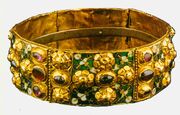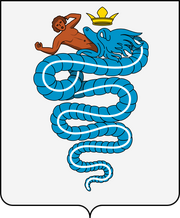| Duchy of Milan Ducatus Mediolani Timeline: Principia Moderni IV (Map Game)
Ducado di Milan OTL equivalent: Duchy of Milan | |||||
|---|---|---|---|---|---|
1395 - 1440 | |||||
|
|||||
| Milan, ca. 1425
|
|||||
| Capital (and city) | Milan | ||||
| Other cities | Verona, Padua, Brescia, Bologna, Modena, Reggio Emilia, Parma | ||||
| Official languages | Latin, Italian | ||||
| Ethnic groups | Lombard | ||||
| Religion | Roman Catholicism | ||||
| Demonym | Milanese | ||||
| Government | Duchy | ||||
| - | Duke | Gian Maria Visconti | |||
| Legislature | Court of Milan | ||||
| History | |||||
| - | Establishment | May 1, 1395 | |||
| Population | |||||
| - | 1440 estimate | 5,250,000 | |||
| Currency | Milanese scudo | ||||
| Patron saint | Saint Ambrose | ||||
The Duchy of Milan (Latin: Ducatus Mediolani; Italian: Ducado di Milan) is a large northern Italian member of the Holy Roman Empire, based out of Milan. The Duchy was founded in 1395 and is currently ruled by the House Visconti.
The Duchy, while still existent as a subdivision of the Kingdom of Italy, was turned into the Kingdom of Italy after that title was granted by the Holy Roman Emperor in 1440 to Niccolò Maria Visconti. Niccolò Maria married Mary of Anjou, Queen of Naples, whose son, Matto would go on to inherit both the Italian and Neapolitan crowns.
History[]
Milan and the duchy centered around it have a rich history as an important center of northern Italian politics, culture, and power. Its history spans from about 400 BC as a Celtic settlement to the modern day in its current form as a Holy Roman duchy.
Ancient Times[]
The Celtic tribe of Insubres was the first documented population to settle around what would come to be known as Insubria and at Milan. The Romans conquered the settlement in 222 BC and named it Mediolanum. After the fall of Rome, Diocletian declared Mediolanum as the capital of the Western Roman Empire in 286 AD. It was here that, in 313 Emperor Constantine issued the Edict of Milan, granting religious freedom to all Christians, making Milan an important site for Christendom.

Iron Crown of Lombardy
Next came a period of instability as Milan was besieged by the Visigoths (402), ravaged by the Huns (452), conquered by the Ostrogoths (539) and then the Lombards (569). The Lombards, a Germanic people, ruled over the city of Milan until its leaders surrendered to Frankish ruler Charlemagne in 774. Charlemagne had himself declared "King of the Lombards" and crowned with the Iron Crown of Lombardy, which has since been used to crown the King of Italy.
Early Middle Ages[]
Milan and the surrounding region, known alternatively as Insubria or Lombardy, became a part of the Holy Roman Empire. In 1150 the Republic of Milan was founded around the comune. The leader of the Republic was known as the podestà, and exercised unilateral authority between regular election periods, which maintained a check on his power.

Flag of the comune of Milan
In 1167, the Republic of Milan was at the forefront of the Lombard League, an effort to reduce the control of the Hohenstaufen Holy Roman Emperors over the Kingdom of Italy. With the backing of the Papacy, a number of important northern Italian city-states rebelled against Frederick I Barbarossa, gaining greater autonomy. The Lombard League was resurrected in 1197 against Henry VI, and for a third time against Frederick II from 1226 to 1250 with its final dissolution.
During the period of the Lombard League, the comune of Milan had been led by the Della Torre family. In 1277, podestà Napoleone Della Torre was challenged by Archbishop of Milan Ottone Visconti for dominance of the city at the Battle of Desio, which he handily won. From that battle onwards, the Visconti family dominated Milanese government.

Coat of Arms of the House Visconti
Following the reign of the Hohenstaufens as Holy Roman Emperors and subsequent acension of the Visconti to local power, Milan gained favor among most of the suceeding Holy Roman Emperors and became the most important city in the Kingdom of Italy (which excluded Venice). In 1395, Gian Galeazzo Visconti, then-Imperial Vicar of Milan, bought a diploma from Emperor Wenceslaus IV of Bohemia, creating the Duchy of Milan, which included 26 towns between the Venice and Savoy.
Late Middle Ages[]
Duke Gian Galeazzo Visconti was not content to simply remain in the towns originally granted by his diploma, but instead set his sights on the unification of all of northern Italy.
1400 - Conquest of Perugia (given to Pope), Montefeltro (given to Pope), Marco Visconti in Genoa, embargo against Florence
1401 - Embargo on Florence continues
1402 - Defeat of Florence in battle, illness of Gian Galeazzo, conquest by Facino Cane, death of Medici clan
1403 - regaining health, defeat of rebellious Cane at Pistoia and gaining new wealth
1404 - war against Venice, which was racked by plague
1405 - marriage of Gian Maria to Margherita degli Albizzi
1406 - birth of Nicolò Maria
1408 - anti-Milanese, Savoyard-led coalition established (followed soon thereafter by Modena/Ferrara)
1410 - falling out between Austria and Milan; Austria joins coalition
1412 - death of Gian Galeazzo Visconti
1413 - alliance with Burgundy, plague begins, Venice/Istria into the HRE, signing Compact of Iskanderun
1414 - War of the Lions breaks out - Milan remains neutral
1418 - condottieres pressure Gian Maria to go to war, fights against Savoy (claim via grandmother Bianca of Savoy), battle of Chivasso
1419 - Filippo Bruschinelli works on Florentine cathedral, hired to work on Duomo di Milano
1420 - Revolts in Florence and Venice as army is still pacifying Savoy
1421 - Defeat of Florentine rebels with Albizzi assistance, start of Venetian embargo/blockade
1422 - Venetian surrender, Gian Maria takes 10,000 men on crusade
1423 - Filippo Maria regency during crusade
1425 - Granted Patria del Friuli
1436 - Gian Maria dies, coronation of Niccolò Maria, birth of Matteo
1437 - Death of Charles IV of Naples, start of War of Neapolitan Succession, coronation of Mary and Niccolò
1438 - Treaty of Pisa
1440 - Promotion to King of Italy
1520: Mario Moltisanti crown Archbishop of Milan
GENERAL: Transcription of manuscripts from the Romans to Charlemagne; building of the Certosa di Pavia and Duomo di Milano
Government[]
Ruled by a Duke of the House Visconti
- Stephano (1287-1327) = Valentina Doria (m. 1318)
- Matteo II (1319-1355) = Egidiola di Filippino (m. 1342)
- Galeazzo II (1320-1378) = Bianca of Savoy (m. 1350)
- Gian Galeazzo (1351-1412) = Isabelle of Valois (m. 1360); Caterina Visconti (m. 1380)
- Gian Galeazzo (1366-1376)
- Azzone (1368-1381)
- Valentina (1371-Present) = Louis, Duke of Orleans (m. 1389)
- Carlo (1373-1374)
- Unnamed Daughter (1385)
- Gian Maria (1388-1436) = Margherita degli Albizzi (m. 1405)
- Niccolò Maria (1406-1462) = Mary, Queen of Naples (m. 1425)
- Matteo (1436-Present) = Caterina Crispo (m. 1455)
- Ottone (1460-Present)
- Benedetta (1439-Present)
- Gherardo (1442-Present)
- Matteo (1436-Present) = Caterina Crispo (m. 1455)
- Bianca (1410-Present) = Wenceslaus V, Holy Roman Emperor (m. 1431)
- Giulio (1411-Present)
- Niccolò Maria (1406-1462) = Mary, Queen of Naples (m. 1425)
- Filippo Maria (1392-Present) = Caterina Cornaro (m. 1412)
- Rosina (1413-Present) = Wiliam Crispo (m. 1436)
- Francesco, Grand Duke of Skopje (1416-Present)
- Isabella (1418-Present) = Olaf Vasa, Crown Prince of Sweden (m. 1441)
- Violante (1354-1386) = Lionel of Antwerp (m. 1368); Secondotto Palaeologus (m. 1377); Ludovico Visconti (m. 1381)
- Gian Galeazzo (1351-1412) = Isabelle of Valois (m. 1360); Caterina Visconti (m. 1380)
- Bernabò Visconti (1323-1385) = Beatrice Regina della Scala (m. 1350)
- Mario Moltisanti, Archbishop Of Milan
Pisa
- Families: Casamatti, Orlandi, Ripafratti, Visconti, Verchionesi, Gusmani, Duodi
Economy[]
Milan is noted for its relatively advanced economy and trading rivalries, both of which are common in its region of northern Italy. Agriculture forms the basis of the rural economy, with rice, cereals, forage, flax, and sugar beets commonly grown in the countryside. Furthermore, mulberries are commonly cultivated for use in sericulture.
Within the cities and villages, industry is beginning to take root. Armor manufacturing, which is necessary for the extensive state of warfare that dominates feudal Europe, is a major industry in Milan and throughout the Duchy's larger cities. The textiles industry is also popular among the Milanese. Both silk manufacturing and the wool trade make Milan the ideal location for textiles production.
Artisans and jewelry-makers are another form of the cottage industry common in the Duchy. Finally, there is a wide sector of the economy which functions off of the patronage of the Visconti family, which commissions grand works of art and architecture on a regular basis to compete with other rival states.
Military[]
Can raise 105,000 troops and 221 ships.
Culture[]
Filippo Bruschinelli and the "Milan School"
Teodosio Giosuè creating the Christening which is a large painting of Jesus being christened.
Foreign Relations[]
Positive
- Naples - Personal Union
- Savoy - Personal Union
- Papal States -
- Bohemia - Alliance
Neutral
Negative
- Ferrara -
Footnotes[]
| |||||||||||||||||||||||||||||||||||




